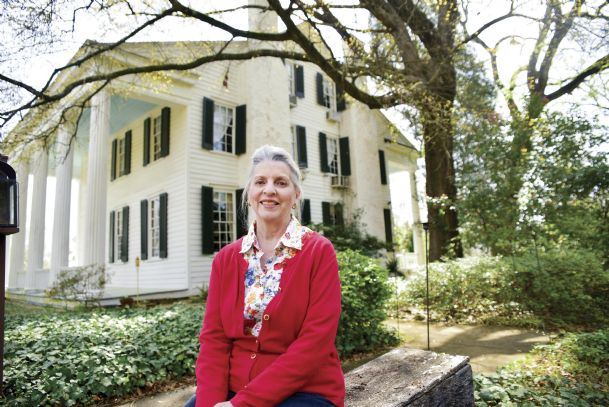When Dixie Butler moved into Temple Heights in the summer of 1969, she had no way of knowing she would spend the next 46 winters and springs preparing the house for visitors to the Columbus Spring Pilgrimage. Every year since, Butler has spent months on preparations for the tours before opening her home to pilgrims from all over the world. But this year will be her last, Butler said. She is in the process of selling Temple Heights.
Despite her page and a half-long to-do list of chores, which she’s been crossing off since January, Butler took some time to chat with The Dispatch about the years she’s spent giving tours in her home.
Temple Heights sits atop a grassy bank on Ninth Street North where it has seen nearly two centuries’ worth of Columbus history and was a stop on the tour of the first Columbus Pilgrimage 75 years ago. When Butler and her husband bought the house in 1967, it was in bad shape, though structurally sound. The realtor suggested they bulldoze it because it wasn’t worth saving, Butler said. Instead, she opened the house for the candlelight Red Tour of the Spring Pilgrimage of 1970.
“You can’t imagine what it looked like that first year,” Butler said. “Fortunately, everything and everybody looked better by candlelight.”
That was back when homeowners who showed their houses for Pilgrimage had to do a lot of the publicity themselves. Butler remembers sorting brochures by zip code while sitting on the floor in empty buildings. Now the Columbus Cultural Heritage Foundation, part of the Columbus-Lowndes Convention and Visitors Bureau, does a lot of publicity, for which Butler is grateful. It’s one of the biggest things that has changed about the Pilgrimage in the years since Butler began showing the house.
Temple Heights was built by Richard T. Brownrigg in 1837, and four families lived in it over the course of the 19th century. It is now listed on the Historic American Buildings Survey and the National Register of Historic Places. It is also an official Mississippi Landmark. Even when Pilgrimage isn’t going on, the house is open for tours.
Butler says one of the biggest changes is that more and more international tourists have visited the house during Pilgrimage. Most of them are from Europe, but she’s also met visitors from China, Japan and countries in South America. Butler always tries to ask them where they’re from.
“I can remember one night that we had people from five different countries that came through,” she said.
Come inside
The Pilgrimage tour of the house begins on the front porch where Butler greets visitors. This is often where she gets one of her most frequently-asked questions: “Do you live here?”
Tourists enter through the front door into the second level of the house. They go through the hallway into the parlor and then the dining room. Next, they go upstairs where the bedrooms are. After touring the bedrooms, they take another flight of steps to the topmost level of the house. The tour then takes them down another stairwell leading to the south-facing porch. From there, visitors see the lowest level of the house and then are taken outside where they view the kitchens and gardens.
“I have people in each room role playing the part of someone who lived here during the 19th century,” Butler said. “They tell what was going on when they lived, and the tourists are really … interested in that.”
Butler said that visitors today ask many of the same questions and have the same interests as those who saw Temple Heights 46 years ago. They are interested in subjects like architecture, gardening and antiques, in addition to the history of the house.
One of her favorite stories is the story of how the first owner, Brownrigg, built the house for his wife, who was homesick for her own home in North Carolina.
“A lot of people will ask me, ‘Well, how much land did they own around here?'” Butler said. “And they’ll think it had been a plantation house, but the plantations were out across the river where the soil is wonderful for farming. When the Brownriggs came, they lived across the river … It was hard for women especially, because of the gumbo consistency of the soil, to visit each other, especially when it was wet. So she was homesick. So her husband built her this house in town just like the one she had grown up in in North Carolina.”
Tourists also ask Butler about her own experiences living in the house.
“Some people ask, ‘How do you mow the bank?'” Butler said. “[We] used to do it with a rope and lower it like that, and I have done that before. … When we first planted ivy on the bank … it would have weeds in it, and so we would sit at the top of the bank with our clippers and slide slowly down the bank, clipping as we went. Then we’d go to the bottom and come up and start again until we had gotten all the weeds pulled.”
A legacy continued
The owners-to-be of Temple Heights have told Butler they will continue to show the house during Pilgrimage. They have already helped Butler prepare the house for this year’s tours.
“They’ll probably be here during the Pilgrimage because they want to see how I have done it,” Butler said. “They may not do it the way I do it. I don’t expect them to do everything the way I’ve done it. But they’ll be here getting a good dose of Pilgrimage.”
As for Butler, leaving Temple Heights after 46 years of living in it and showing it to visitors is bittersweet.
“I can certainly tear up when I think about it, but I’m so delighted with the people that are going to get the house,” she said.
Nancy Carpenter, who is CEO and executive director of the Columbus Cultural Heritage Foundation, said that Butler’s contribution to Pilgrimage and her devotion to showing her home has been invaluable for tourism in Columbus.
“The work she has done has been extraordinary,” Carpenter said.
“I have felt like the steward of this house, and I wanted for the next people to also be good stewards of the house, and they’re going to be,” said Butler. “They’re going to be wonderful.”
It may be the end of her showing Temple Heights as its owner, but Butler feels sure her involvement with Pilgrimage will not end with her move.
“I’m sure I’ll be doing something,” she said. “I can’t not.”
You can help your community
Quality, in-depth journalism is essential to a healthy community. The Dispatch brings you the most complete reporting and insightful commentary in the Golden Triangle, but we need your help to continue our efforts. In the past week, our reporters have posted 37 articles to cdispatch.com. Please consider subscribing to our website for only $2.30 per week to help support local journalism and our community.




